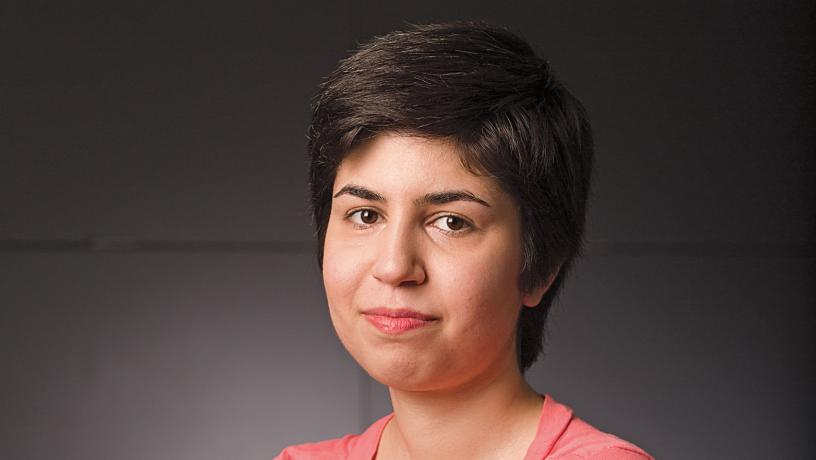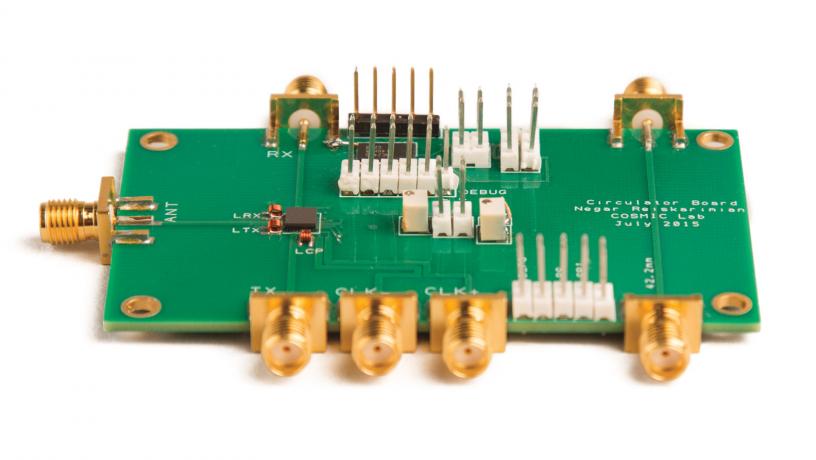Electrical Engineering PhD Student Negar Reiskarimian Honored As 2018 DARPA Riser
Electrical Engineering PhD candidate Negar Reiskarimian has been named a 2018 Riser by the U.S. Defense Advanced Research Projects Agency (DARPA). As one of 50 fellow honorees, Reiskarimian presented her work at DARPA’s 60th annual symposium last month, which brought together exceptional emerging scientists and engineers to discuss novel ideas and technological breakthroughs.

PhD candidate Negar Reiskarimian

First CMOS full duplex receiver IC with integrated magnetic-free circulator
Reiskarimian’s research holds the promise to double WiFi capabilities for microchips at less than half the size of current models. “We have demonstrated the world’s first CMOS passive magnetic-free non-reciprocal circulator through spatio-temporal conductivity modulation,” she wrote in her Riser submission. “This novel approach to breaking Lorentz reciprocity based on linear periodically-time-varying (LPTV) circuits has emerging applications in the next generation of wireless communication networks.”
DARPA support is critical to breakthroughs like these, says Professor Harish Krishnaswamy, head of the Columbia high-Speed and Millimeter-wave IC (CoSMIC) lab and Reiskarimian’s advisor. “CoSMIC has been supported by numerous DARPA programs over the last 10 years. These programs have allowed us to make advances in many areas, including millimeter-wave wireless technology, full-duplex wireless technology, and—in the case of Reiskarimian’s research—in non-reciprocal components,” Krishnaswamy said.
Krishnaswamy's lab is the first to put an RF circulator on a silicon chip and show that WiFi capacity can be doubled with a single antenna.
Reiskarimian’s research interests include integrated circuits and systems, applied electromagnetics, and nanophotonics, with a focus on analog, radio-frequency, millimeter-wave and optical integrated circuits, metamaterials, and systems for a variety of applications, from emerging wireless communications paradigms to IoT, imaging, sensing, and opto/bio-electronics.
Established in 1958 by the U.S. Department of State, DARPA is a leading driver of major breakthroughs in global communications, national security, and technology. Over 1,500 scientists and engineers from government, academia, and corporations attended the 2018 symposium; Reiskarimian presented her research to DARPA officials, program managers, and a diverse audience of engineers and scientists from across the U.S. Department of Defense.
The DARPA honor is just the latest in a string of awards for Reiskarimian, including Forbes “30 under 30,” the Marconi Society Paul Baran Young Scholar Award, the Qualcomm Innovation Fellowship, and the IEEE Solid-State Circuits Society Predoctoral Achievement Award.
Next fall, Reiskarimian will join the faculty at MIT as an assistant professor of electrical engineering and computer science. Her goal is to explore, from an interdisciplinary perspective, novel fundamental physical concepts that have strong engineering applications to shape the world with new technologies.
